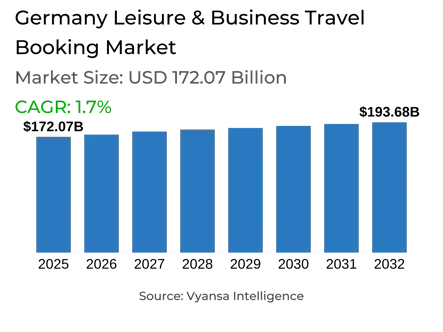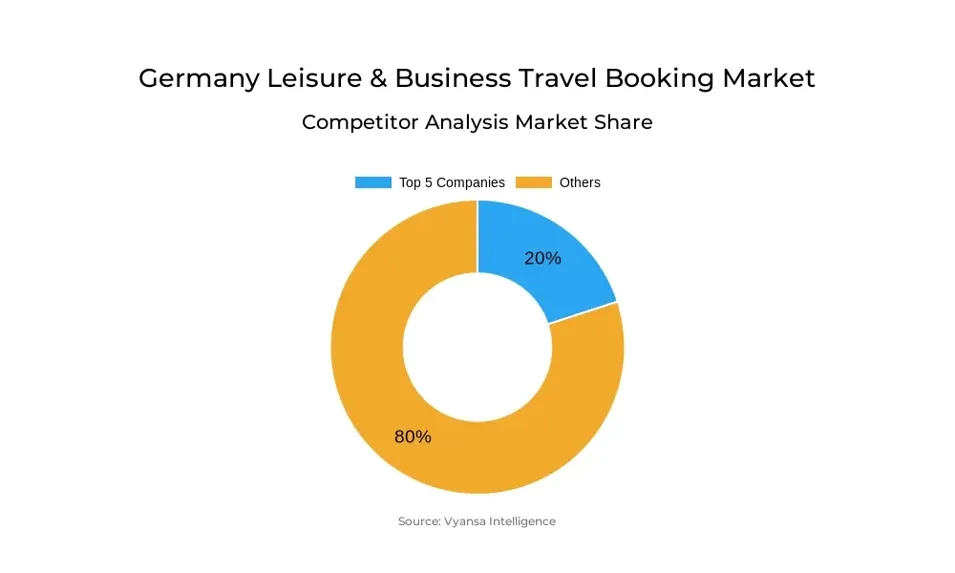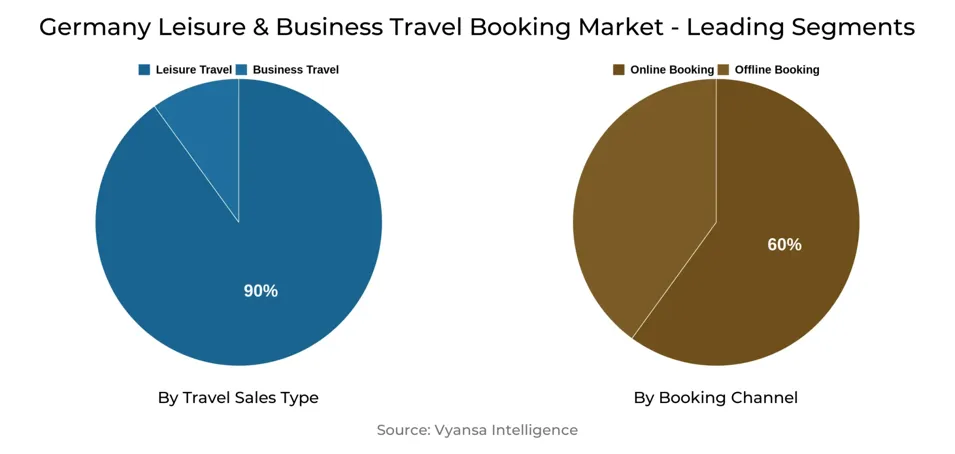
Germany Leisure & Business Travel Booking Market Report: Trends, Growth and Forecast (2026-2032)
By Travel Sales Type (Leisure Travel, Business Travel), By Booking Channel (Offline Booking, Online Booking), By Booking Method (Travel Intermediaries, Direct Suppliers)
- ICT
- Nov 2025
- VI0390
- 115
-




Germany Leisure & Business Travel Booking Market Statistics and Insights, 2026
- Market Size Statistics
- Leisure & Business Travel Booking in Germany is estimated at $ 172.07 Billion.
- The market size is expected to grow to $ 193.68 Billion by 2032.
- Market to register a CAGR of around 1.7% during 2026-32.
- Travel Sales Type Shares
- Leisure Travel grabbed market share of 90%.
- Competition
- Germany Leisure & Business Travel Booking Market is currently being catered to by more than 15 companies.
- Top 5 companies acquired 20% of the market share.
- Schmetterling Reisen GmbH & Co KG, Reiseland Holding GmbH, Lufthansa City Center Reisebüropartner GmbH, Dertour Deutschland GmbH, TUI Deutschland GmbH etc., are few of the top companies.
- Booking Channel
- Online Booking grabbed 60% of the market.
Germany Leisure & Business Travel Booking Market Outlook
The Leisure & Business Travel Booking market in Germany is estimated at $172.07 billion in 2025 and is expected to grow to $193.68 billion by 2032. Online reservations are becoming more popular, accounting for about 65% of the market, since visitors appreciate convenience, efficiency, and affordability. Web and mobile platforms will dominate as the major channels, particularly for spontaneous reservations and customised travels, while offline reservations will still appeal to mature visitors who prefer direct experience and expert consultancy.
Travel for leisure will remain on a steady growth path, and German end users will be keen on medium- and long-haul destinations. Economic volatility and cost-of-living issues will affect consumption, but numerous travelers will still keep their priorities on experiences as well as convenience. Business travel will grow as firms come back to conducting face-to-face meetings and conferences, driving bookings through both online and offline mediums.
Technological advancement will have a defining impact on the market. The convergence of artificial intelligence and virtual reality functionalities will offer more tailored and engaging booking experiences. Travelers will increasingly depend on these technologies to experience destinations remotely, manage expectations, and make smart decisions, enabling travel companies to stand out in a competitive environment.
Sustainability will also become a key factor, as travelers will expect responsible and environmentally friendly travel possibilities. Travel intermediaries that establish sustainable processes as part of their offerings without increasing costs notably for customers will be able to gain market strength. The market will generally develop on the basis of digitalisation, customisation, and increased emphasis on sustainability, providing challenges and opportunities for German travel intermediaries alike.

Germany Leisure & Business Travel Booking Market Growth Driver
Effective Brand Repositioning Reinforces Market Position
Germany Leisure & Business Travel Booking Market is being driven by brand repositioning, as companies adapt to evolving consumer preferences and increasing competitive pressures. The rebranding of Der Touristik to Dertour improves its profile and confirms end user confidence, resulting in a powerful and trustworthy brand name in the market. By consolidating its services and showcasing itself in a more end user-focused manner, the brand attracts leisure and business travelers who demand varied and reliable travel options.
This transformation illustrates how a robust brand image builds competitiveness in a segmented and dynamic business. In a market whose landscape is influenced by changing end user behavior and whose other players are facing difficulties, firms that manage to reinforce their brand image are able to maintain customer loyalty and gain new end users. This capacity to reposition and evolve makes brand robustness a central force of competitiveness and market expansion in Germany.
Germany Leisure & Business Travel Booking Market Trend
Technology Improves Travel Experience
Artificial intelligence and virtual reality technologies are transforming the way Germans book and experience travel. AI facilitates personalised suggestions, optimized itineraries, and real-time assistance, while virtual reality enables visitors to experience destinations and hotels prior to making a booking. This results in a more enlightened and enjoyable travel experience, enabling end users to make informed decisions.
With advancing technology, German travel suppliers are increasingly adopting these tools to interact with customers and differentiate their offerings. The interactive and immersive experience resonates with a digitally literate end user, helping foster repeat usage and customer loyalty, a clear departure from the way German travel decisions are made
Germany Leisure & Business Travel Booking Market Opportunity
Sustainable Travel as a Differentiator
End users in Germany are becoming more aware of sustainability and like to choose environmentally friendly alternatives when organizing a trip. Even though they do not pay extra for green solutions, they welcome it when service providers embrace sustainable actions like carbon-neutral transportation, ecologically certified accommodations, and energy-efficient services.
Tourism businesses that integrate sustainability into their products without increasing prices can capture green travelers while enhancing brand image. This is not only fulfilling the expectations of end users but also offering a sustainable long-term growth prospect to suppliers who can reconcile affordability with green values in their business and holiday travel services.
Germany Leisure & Business Travel Booking Market Segmentation Analysis

By Travel Sales Type
- Leisure Travel
- Business Travel
The segment with the highest market share under Travel Sales Type is Leisure Travel, which captured almost 90% of the market. German travelers still give top priority to leisure travel despite economic volatility and the cost-of-living crisis. The overwhelming tendency towards leisure bookings proves that this segment is robust, as customers continue to yearn for travelling experiences while accommodating price sensitivity and value-driven options.
While that is happening, business travel has also started to recover with the reopening of physical offices and firms going back to conducting in-person conferences and meetings. Its proportion, however, is still relatively smaller. Leisure travel leads the charge as it is attractive to a wide base of customers in all age groups, with offline and online channels offering diverse choices in managing and reserving their trips.
By Booking Channel
- Offline Booking
- Online Booking
The largest market segment under the Booking Channel is Online Booking with a market share of 60%. Internet transaction value continues to outrank offline channels as German end users increasingly opt for the convenience and cost benefits of booking online. The uptake of digital platforms is further influenced by new technologies providing personalisation, immersive previews, and economic flexibility.
However, offline bookings have also remained resilient, exceeding 2019 volumes in 2024. Older generations of German travelers still stick to physical offices of agencies due to face-to-face contact and the advice of well-known travel agents. Business trips are also contributing to this rebound. However, the consistent rise of digitalization and AI-based booking activities guarantees that the majority of bookings still take place online, defining future expansion in the market.
Top Companies in Germany Leisure & Business Travel Booking Market
The top companies operating in the market include Schmetterling Reisen GmbH & Co KG, Reiseland Holding GmbH, Lufthansa City Center Reisebüropartner GmbH, Dertour Deutschland GmbH, TUI Deutschland GmbH, Booking.com BV, BCD Travel Germany GmbH, Expedia.com GmbH, Opodo Ltd, Hotel Reservation Service (HRS) Robert Ragge GmbH, etc., are the top players operating in the Germany Leisure & Business Travel Booking Market.
Frequently Asked Questions
Related Report
1. Market Segmentation
1.1. Research Scope
1.2. Research Methodology
1.3. Definitions and Assumptions
2. Executive Summary
3. Germany Leisure & Business Travel Booking Market Policies, Regulations, and Standards
4. Germany Leisure & Business Travel Booking Market Dynamics
4.1. Growth Factors
4.2. Challenges
4.3. Trends
4.4. Opportunities
5. Germany Leisure & Business Travel Booking Market Statistics, 2022-2032F
5.1. Market Size & Growth Outlook
5.1.1. By Revenues in US$ Million
5.2. Market Segmentation & Growth Outlook
5.2.1. By Travel Sales Type
5.2.1.1. Leisure Travel- Market Insights and Forecast 2022-2032, USD Million
5.2.1.2. Business Travel- Market Insights and Forecast 2022-2032, USD Million
5.2.2. By Booking Channel
5.2.2.1. Offline Booking- Market Insights and Forecast 2022-2032, USD Million
5.2.2.2. Online Booking- Market Insights and Forecast 2022-2032, USD Million
5.2.3. By Booking Method
5.2.3.1. Travel Intermediaries- Market Insights and Forecast 2022-2032, USD Million
5.2.3.2. Direct Suppliers- Market Insights and Forecast 2022-2032, USD Million
5.2.4. By Competitors
5.2.4.1. Competition Characteristics
5.2.4.2. Market Share & Analysis
6. Germany Leisure Travel Booking Market Statistics, 2022-2032F
6.1. Market Size & Growth Outlook
6.1.1. By Revenues in US$ Million
6.2. Market Segmentation & Growth Outlook
6.2.1. By Travel Sales Type- Market Insights and Forecast 2022-2032, USD Million
6.2.1.1. Leisure Air Travel- Market Insights and Forecast 2022-2032, USD Million
6.2.1.2. Leisure Car Rental- Market Insights and Forecast 2022-2032, USD Million
6.2.1.3. Leisure Cruise- Market Insights and Forecast 2022-2032, USD Million
6.2.1.4. Leisure Experiences and Attractions- Market Insights and Forecast 2022-2032, USD Million
6.2.1.5. Leisure Lodging- Market Insights and Forecast 2022-2032, USD Million
6.2.2. By Booking Channel- Market Insights and Forecast 2022-2032, USD Million
6.2.3. By Booking Method- Market Insights and Forecast 2022-2032, USD Million
7. Germany Business Travel Booking Market Statistics, 2022-2032F
7.1. Market Size & Growth Outlook
7.1.1. By Revenues in US$ Million
7.2. Market Segmentation & Growth Outlook
7.2.1. By Travel Sales Type- Market Insights and Forecast 2022-2032, USD Million
7.2.1.1. Business Air Travel- Market Insights and Forecast 2022-2032, USD Million
7.2.1.2. Business Car Rental- Market Insights and Forecast 2022-2032, USD Million
7.2.1.3. Business Lodging- Market Insights and Forecast 2022-2032, USD Million
7.2.1.4. Others- Market Insights and Forecast 2022-2032, USD Million
7.2.2. By Booking Channel- Market Insights and Forecast 2022-2032, USD Million
7.2.3. By Booking Method- Market Insights and Forecast 2022-2032, USD Million
8. Competitive Outlook
8.1. Company Profiles
8.1.1. Dertour Deutschland GmbH
8.1.1.1. Business Description
8.1.1.2. Service Portfolio
8.1.1.3. Collaborations & Alliances
8.1.1.4. Recent Developments
8.1.1.5. Financial Details
8.1.1.6. Others
8.1.2. TUI Deutschland GmbH
8.1.2.1. Business Description
8.1.2.2. Service Portfolio
8.1.2.3. Collaborations & Alliances
8.1.2.4. Recent Developments
8.1.2.5. Financial Details
8.1.2.6. Others
8.1.3. Booking.com BV
8.1.3.1. Business Description
8.1.3.2. Service Portfolio
8.1.3.3. Collaborations & Alliances
8.1.3.4. Recent Developments
8.1.3.5. Financial Details
8.1.3.6. Others
8.1.4. BCD Travel Germany GmbH
8.1.4.1. Business Description
8.1.4.2. Service Portfolio
8.1.4.3. Collaborations & Alliances
8.1.4.4. Recent Developments
8.1.4.5. Financial Details
8.1.4.6. Others
8.1.5. Expedia.com GmbH
8.1.5.1. Business Description
8.1.5.2. Service Portfolio
8.1.5.3. Collaborations & Alliances
8.1.5.4. Recent Developments
8.1.5.5. Financial Details
8.1.5.6. Others
8.1.6. Schmetterling Reisen GmbH & Co KG
8.1.6.1. Business Description
8.1.6.2. Service Portfolio
8.1.6.3. Collaborations & Alliances
8.1.6.4. Recent Developments
8.1.6.5. Financial Details
8.1.6.6. Others
8.1.7. Reiseland Holding GmbH
8.1.7.1. Business Description
8.1.7.2. Service Portfolio
8.1.7.3. Collaborations & Alliances
8.1.7.4. Recent Developments
8.1.7.5. Financial Details
8.1.7.6. Others
8.1.8. Lufthansa City Center Reisebüropartner GmbH
8.1.8.1. Business Description
8.1.8.2. Service Portfolio
8.1.8.3. Collaborations & Alliances
8.1.8.4. Recent Developments
8.1.8.5. Financial Details
8.1.8.6. Others
8.1.9. Opodo Ltd
8.1.9.1. Business Description
8.1.9.2. Service Portfolio
8.1.9.3. Collaborations & Alliances
8.1.9.4. Recent Developments
8.1.9.5. Financial Details
8.1.9.6. Others
8.1.10. Hotel Reservation Service (HRS) Robert Ragge GmbH
8.1.10.1. Business Description
8.1.10.2. Service Portfolio
8.1.10.3. Collaborations & Alliances
8.1.10.4. Recent Developments
8.1.10.5. Financial Details
8.1.10.6. Others
9. Disclaimer
| Segment | Sub-Segment |
|---|---|
| By Travel Sales Type |
|
| By Booking Channel |
|
| By Booking Method |
|
Research Methodology
This study followed a structured approach comprising four key phases to assess the size and scope of the electro-oxidation market. The process began with thorough secondary research to collect data on the target market, related markets, and broader industry context. These findings, along with preliminary assumptions and estimates, were then validated through extensive primary research involving industry experts from across the value chain. To calculate the overall market size, both top-down and bottom-up methodologies were employed. Finally, market segmentation and data triangulation techniques were applied to refine and validate segment-level estimations.
Secondary Research
The secondary research phase involved gathering data from a wide range of credible and published sources. This step helped in identifying industry trends, defining market segmentation, and understanding the market landscape and value chain.
Sources consulted during this phase included:
- Company annual reports, investor presentations, and press releases
- Industry white papers and certified publications
- Trade directories and market-recognized databases
- Articles from authoritative authors and reputable journals
- Gold and silver standard websites
Secondary research was critical in mapping out the industry's value chain and monetary flow, identifying key market segments, understanding regional variations, and tracking significant industry developments.
Other key sources:
- Financial disclosures
- Industry associations and trade bodies
- News outlets and business magazines
- Academic journals and research studies
- Paid industry databases
Primary Research
To validate secondary data and gain deeper market insights, primary research was conducted with key stakeholders across both the supply and demand sides of the market.
On the demand side, participants included decision-makers and influencers from end-user industries—such as CIOs, CTOs, and CSOs—who provided first-hand perspectives on market needs, product usage, and future expectations.
On the supply side, interviews were conducted with manufacturers, industry associations, and institutional participants to gather insights into current offerings, product pipelines, and market challenges.
Primary interviews provided critical inputs such as:
- Market size and revenue data
- Product and service breakdowns
- Market forecasts
- Regional and application-specific trends
Stakeholders consulted included:
- Leading OEM and solution providers
- Channel and distribution partners
- End users across various applications
- Independent consultants and industry specialists
Market Size Estimation and Data Triangulation
- Identifying Key Market Participants (Secondary Research)
- Goal: To identify the major players or companies in the target market. This typically involves using publicly available data sources such as industry reports, market research publications, and financial statements of companies.
- Tools: Reports from firms like Gartner, Forrester, Euromonitor, Statista, IBISWorld, and others. Public financial statements, news articles, and press releases from top market players.
- Extracting Earnings of Key Market Participants
- Goal: To estimate the earnings generated from the product or service being analyzed. This step helps in understanding the revenue potential of each market player in a specific geography.
- Methods: Earnings data can be gathered from:
- Publicly available financial reports (for listed companies).
- Interviews and primary data sources from professionals, such as Directors, VPs, SVPs, etc. This is especially useful for understanding more nuanced, internal data that isn't publicly disclosed.
- Annual reports and investor presentations of key players.
- Data Collation and Development of a Relevant Data Model
- Goal: To collate inputs from both primary and secondary sources into a structured, data-driven model for market estimation. This model will incorporate key market KPIs and any independent variables relevant to the market.
- Key KPIs: These could include:
- Market size, growth rate, and demand drivers.
- Industry-specific metrics like market share, average revenue per customer (ARPC), or average deal size.
- External variables, such as economic growth rates, inflation rates, or commodity prices, that could affect the market.
- Data Modeling: Based on this data, the market forecasts are developed for the next 5 years. A combination of trend analysis, scenario modeling, and statistical regression might be used to generate projections.
- Scenario Analysis
- Goal: To test different assumptions and validate how sensitive the market is to changes in key variables (e.g., market demand, regulatory changes, technological disruptions).
- Types of Scenarios:
- Base Case: Based on current assumptions and historical data.
- Best-Case Scenario: Assuming favorable market conditions, regulatory environments, and technological advancements.
- Worst-Case Scenario: Accounting for adverse factors, such as economic downturns, stricter regulations, or unexpected disruptions.
Partnering With Industry Leaders to Drive Growth
Our mission is to deliver intelligence that matters. By combining data, analysis, and industry expertise, we enable organizations to make smarter, faster, and more impactful decisions. Whether it’s a Fortune 500 company or a high-growth startup, businesses trust us to provide clarity in an ever-evolving marketplace.






